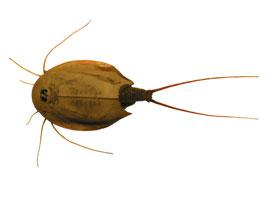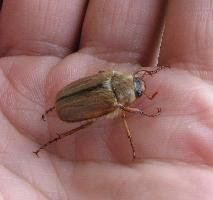
Greutăți și măsuri
| Lungime | 10 cm |
|---|
Starea de conservare
| Amenințat |
Descrierea animalului
The European tadpole shrimp, scientifically named Triops cancriformis, is a fascinating and ancient species of freshwater crustacean that has captivated the interest of scientists and nature enthusiasts alike. This intriguing creature belongs to the order Notostraca, and it has a history that stretches back over 220 million years, making it one of the oldest living species on Earth. Its resilience and adaptability through countless epochs speak volumes about its unique biological makeup and survival strategies.The physical appearance of the European tadpole shrimp is quite remarkable and is the source of its common name. The body is broadly divided into two main sections: a large, shield-like carapace that covers the head and thorax, giving it a tadpole-like silhouette, and a long, segmented abdomen that ends in a forked tail. This protective carapace is not only a defensive armor but also aids in buoyancy. The creature can grow up to 11 centimeters in length, although sizes vary widely among different habitats and environmental conditions.
One of the most distinctive features of Triops cancriformis is its numerous appendages, which serve various purposes. It has up to 70 pairs of leaf-like legs located underneath the carapace, which are used for swimming, breathing, and feeding. These legs create a fascinating spectacle as they ripple in unison while the tadpole shrimp moves through the water. The front legs are specialized for gathering food, which consists of detritus, small invertebrates, and organic matter, making it an omnivorous scavenger.
The European tadpole shrimp inhabits temporary freshwater pools, ponds, and slow-moving bodies of water across Europe and parts of Asia and Africa. These ephemeral aquatic environments are crucial for the lifecycle of Triops cancriformis, which has adapted to survive dry periods as eggs. The eggs are remarkably resilient and can remain dormant for several years, hatching only when the conditions are favorable, including the right temperature and moisture levels. This unique adaptation ensures the survival of the species through periods of drought and environmental change.
Reproduction in Triops cancriformis is primarily parthenogenetic, meaning that females can produce offspring without fertilization by males. However, sexual reproduction does occur under certain conditions, contributing to genetic diversity within the population. The rapid lifecycle, from egg to adult in just a few weeks, allows for several generations to occur within a single season, depending on the availability of water.
Despite its ancient lineage and adaptability, the European tadpole shrimp faces threats from habitat destruction, pollution, and climate change. The specific conditions required for the hatching of eggs and the survival of juveniles make it vulnerable to environmental changes. Conservation efforts are essential to preserve this living fossil and the ecosystems it inhabits.
In summary, the European tadpole shrimp, Triops cancriformis, is a remarkable species that offers a glimpse into the distant past. Its unique physiological and ecological characteristics, combined with its ancient heritage, make it a subject of great interest and importance in the study of evolutionary biology, ecology, and conservation.
Animale similare
Fotografii noi cu animale
Top 10 animale
- Dolphin gull (Leucophaeus scoresbii)
- Diana monkey (Cercopithecus diana)
- Moustached guenon (Cercopithecus cephus)
- Galápagos tortoise (Geochelone nigra complex)
- Russian tortoise (Testudo horsfieldii)
- Stone loach (Barbatula barbatula)
- Japanese macaque (Macaca fuscata)
- Greek tortoise (Testudo graeca)
- Common flying dragon (Draco volans)
- Vendace (Coregonus albula)


